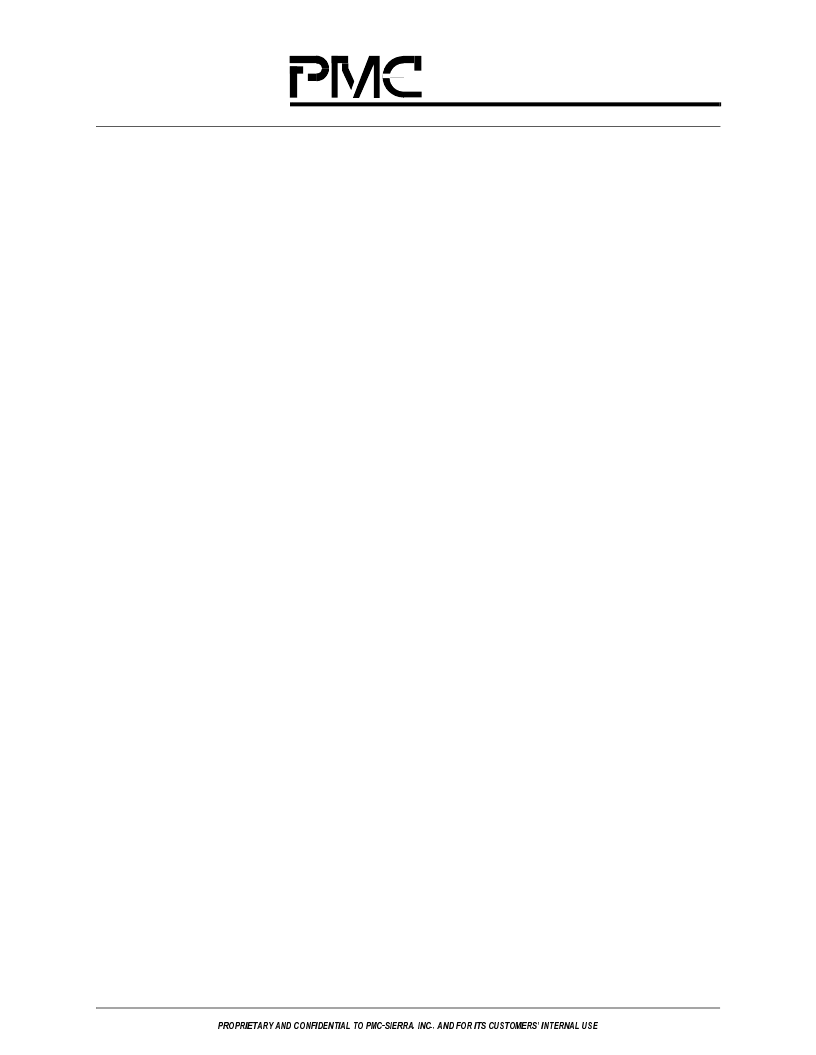- 您現(xiàn)在的位置:買賣IC網(wǎng) > PDF目錄378055 > PM73121 (PMC-SIERRA INC) AAL1 Segmentation And Reassembly Processor PDF資料下載
參數(shù)資料
| 型號: | PM73121 |
| 廠商: | PMC-SIERRA INC |
| 元件分類: | 數(shù)字傳輸電路 |
| 英文描述: | AAL1 Segmentation And Reassembly Processor |
| 中文描述: | ATM SEGMENTATION AND REASSEMBLY DEVICE |
| 文件頁數(shù): | 53/223頁 |
| 文件大?。?/td> | 2300K |
| 代理商: | PM73121 |
第1頁第2頁第3頁第4頁第5頁第6頁第7頁第8頁第9頁第10頁第11頁第12頁第13頁第14頁第15頁第16頁第17頁第18頁第19頁第20頁第21頁第22頁第23頁第24頁第25頁第26頁第27頁第28頁第29頁第30頁第31頁第32頁第33頁第34頁第35頁第36頁第37頁第38頁第39頁第40頁第41頁第42頁第43頁第44頁第45頁第46頁第47頁第48頁第49頁第50頁第51頁第52頁當前第53頁第54頁第55頁第56頁第57頁第58頁第59頁第60頁第61頁第62頁第63頁第64頁第65頁第66頁第67頁第68頁第69頁第70頁第71頁第72頁第73頁第74頁第75頁第76頁第77頁第78頁第79頁第80頁第81頁第82頁第83頁第84頁第85頁第86頁第87頁第88頁第89頁第90頁第91頁第92頁第93頁第94頁第95頁第96頁第97頁第98頁第99頁第100頁第101頁第102頁第103頁第104頁第105頁第106頁第107頁第108頁第109頁第110頁第111頁第112頁第113頁第114頁第115頁第116頁第117頁第118頁第119頁第120頁第121頁第122頁第123頁第124頁第125頁第126頁第127頁第128頁第129頁第130頁第131頁第132頁第133頁第134頁第135頁第136頁第137頁第138頁第139頁第140頁第141頁第142頁第143頁第144頁第145頁第146頁第147頁第148頁第149頁第150頁第151頁第152頁第153頁第154頁第155頁第156頁第157頁第158頁第159頁第160頁第161頁第162頁第163頁第164頁第165頁第166頁第167頁第168頁第169頁第170頁第171頁第172頁第173頁第174頁第175頁第176頁第177頁第178頁第179頁第180頁第181頁第182頁第183頁第184頁第185頁第186頁第187頁第188頁第189頁第190頁第191頁第192頁第193頁第194頁第195頁第196頁第197頁第198頁第199頁第200頁第201頁第202頁第203頁第204頁第205頁第206頁第207頁第208頁第209頁第210頁第211頁第212頁第213頁第214頁第215頁第216頁第217頁第218頁第219頁第220頁第221頁第222頁第223頁

PM73121AAL1gator II
PMC-Sierra, Inc.
L
PMC-980620
,VVXH
AAL1 SAR Processor
Data Sheet
35235,(7$5<$1'&21),'(17,$/7230&6,(55$,1&$1')25,76&86720(56,17(51$/86(
7. The CSD circuit computes the number of credits for those nine frames and adds the result to
the total.
New credits = 9
×
4 = 36
QUE_CREDITS = 36 + 12.5 = 48.5
If the queue is on a line in SDF-MF mode, the CSD makes a signaling adjustment to the
QUE_CREDITS before writing this value to memory. (If the queue is not in SDF-MF mode,
the signaling adjustment is not made and the QUE_CREDITS calculated in Step 7 is written
to memory.)
The calculation determines the number of signaling bytes in the structure, then generates an
average number of signaling bytes inserted into cells per frame, and finally multiplies this
average number by the frame differential to adjust the QUE_CREDITS.
8. The CSD converts the frame differential from units of frames to units of one-eighth of multi-
frames.
In performing this calculation, the CSD also uses the FRAME_REMAINDER value from the
QUE_CREDITS location in the T_QUEUE_TBL. This example assumes that FRAME_
REMAINDER = 1 from the previous calculation on this queue.
E1: Frame differential (in eighths of a multiframe) = (frame differential + FRAME_
REMAINDER)
÷
2
T1: Frame differential (in eighths of a multiframe) = (frame differential + FRAME_
REMAINDER)
÷
3
Frame differential = (9 + 1)
÷
3 = 10, or three-eighths of a multiframe, remainder 1.
The CSD writes the remainder of this division into the FRAME_REMAINDER location for
use in the next calculation on this queue.
9. The CSD calculates the signaling credit adjustment by multiplying the frame differential
expressed in eighths of a multiframe by the number of signaling bytes in a structure.
Number of signaling bytes in the structure = 4 channels
×
0.5 bytes per channel = 2 bytes
per multiframe
Signaling adjustment = three eighths
×
2 = 0.75 bytes
10. Then the CSD adds the signaling credit adjustment to the total and writes the result to mem-
ory, in preparation for the next service on this queue.
QUEUE_CREDITS = 48.5 + 0.75 = 49.25 bytes
Unstructured lines use the same procedure. In the case of unstructured lines, the number of chan-
nels allocated to the queue is 32. Because there is never a pointer, the average number of credits
spent per cell is always 47.
相關PDF資料 |
PDF描述 |
|---|---|
| PM73121-RI | AAL1 Segmentation And Reassembly Processor |
| PM73122 | 32 LINK CES/DBCES AAL1 SAR PROCESSOR |
| PM73122-BI | 32 LINK CES/DBCES AAL1 SAR PROCESSOR |
| PM73123 | 8 LINK CES/DBCES AAL1 SAR |
| PM73123-PI | 8 LINK CES/DBCES AAL1 SAR |
相關代理商/技術參數(shù) |
參數(shù)描述 |
|---|---|
| PM73121-RI | 制造商:PMC 制造商全稱:PMC 功能描述:AAL1 Segmentation And Reassembly Processor |
| PM73122 | 制造商:PMC 制造商全稱:PMC 功能描述:32 LINK CES/DBCES AAL1 SAR PROCESSOR |
| PM73122-BI | 制造商:PMC 制造商全稱:PMC 功能描述:32 LINK CES/DBCES AAL1 SAR PROCESSOR |
發(fā)布緊急采購,3分鐘左右您將得到回復。